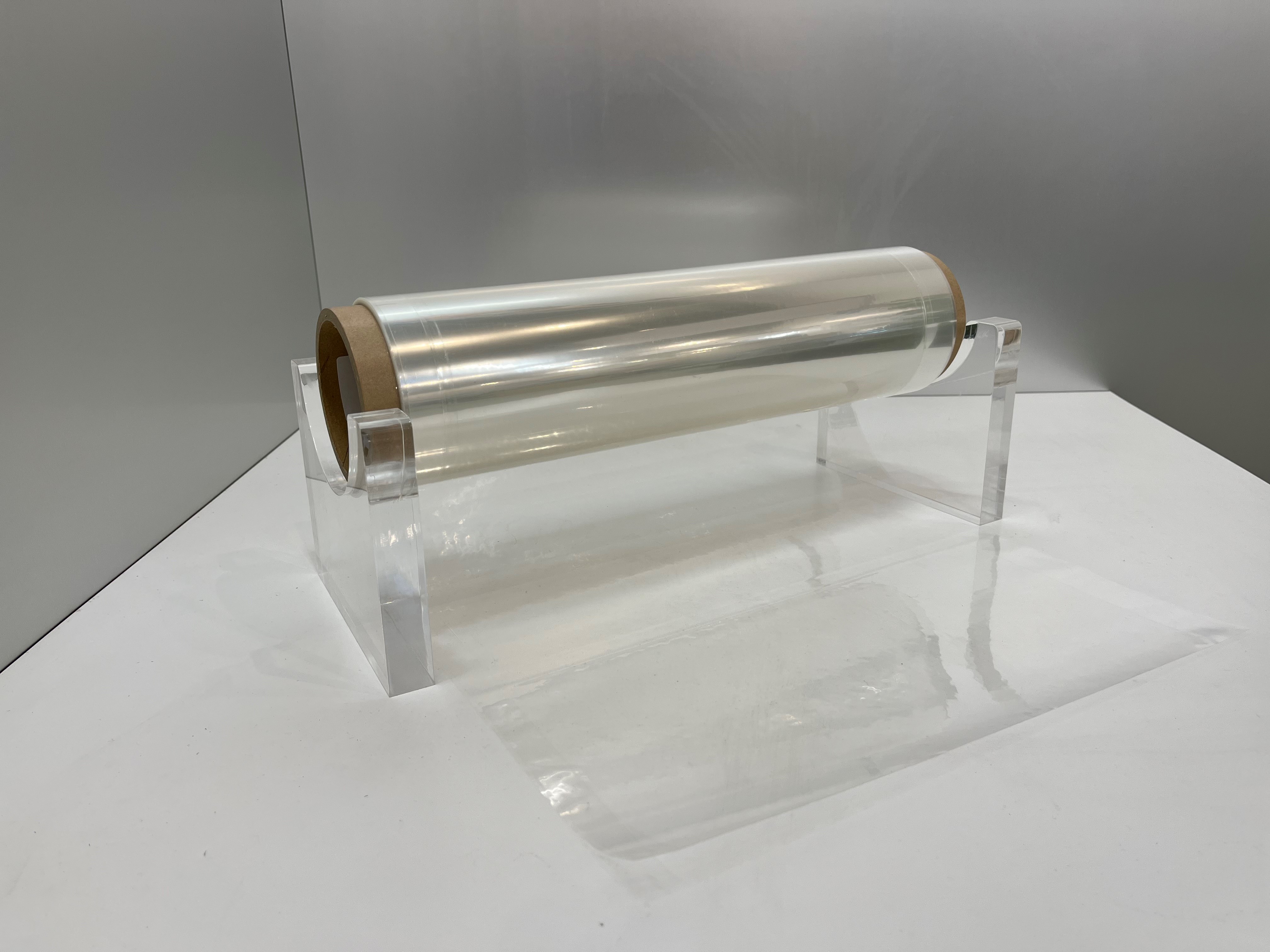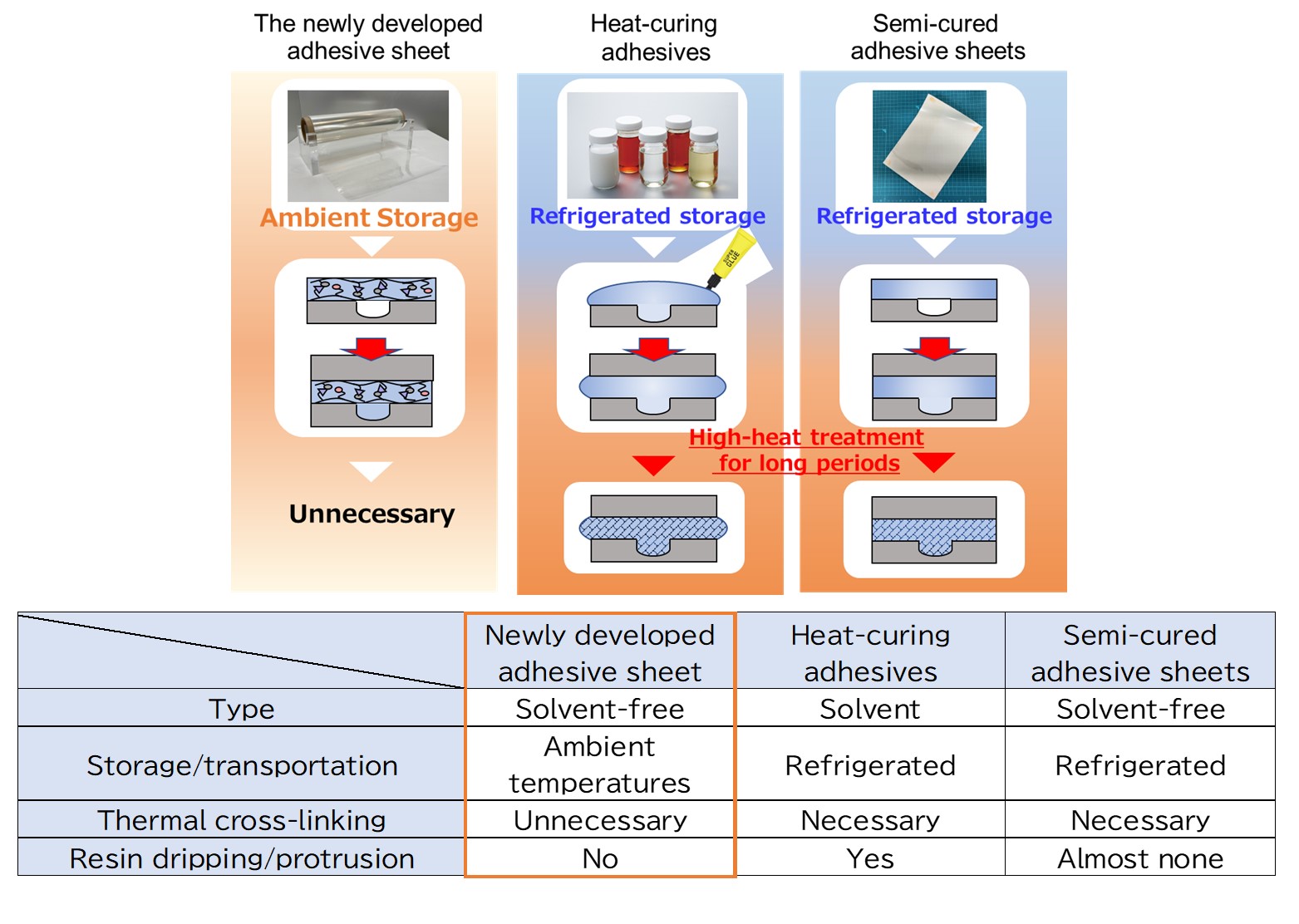Putting vitrimers (resin possessing dynamic covalent bonds with associative bond exchange mechanism) into practical use for electronic materials
New high-heat resistant, eco-friendly adhesive sheet is solvent-free; can be distributed at ambient temperatures
Toyobo Co., Ltd. and Toyobo MC Corporation (here after “the Group”) have jointly developed an eco-friendly, high-heat-resistant polyester adhesive sheet for electronic materials by applying a new class of cross-linked*1 resins called “vitrimers.*2” This adhesive sheet is solvent-free, and can be transported and stored at ambient temperatures.
Vitrimers are a new class of cross-linked resins, which possess dynamic covalent bonds with associative bond exchange mechanism. The new product was developed by taking advantage of vitrimers’ property to respond to pressure and heat — just like thermoplastic resins — while maintaining the cross-linked state of polymers. Toyobo MC Corporation plans to start providing samples, manufacturing and selling the product to electronic material makers soon.

Demand for high-heat-resistant adhesive sheets used for adhering electronic parts to flexible printed circuits and other components has sharply increased due to the need to include greater numbers of electronic parts in products as well as in integrated circuits. This trend has been accelerated by the advent of high-speed data communications, electrification of automobiles and progress in digital transformation (DX).
In recent years, the need for solvent-free, heat-curing adhesive sheets has increased in order to reduce the impact on the environment. But the use of such adhesive sheets is problematic, because they have to be stored or transported in a refrigerated state to prevent them from curing in ambient temperatures. In addition, such sheets require a thermal cross-linking treatment that accompanies heating for a certain length of time after the sheet comes into contact with an object to fix their bonding.
The new product that the Group has developed is a solvent-free polyester adhesive sheet that resists high heat by applying vitrimers to part of the resin’s structure. Since 2019, Toyobo has been conducting a joint research project with the Nagoya Institute of Technology (NIT). Specifically, Toyobo and NIT have studied how to design vitrimers to maximize their ability to deform in response to pressure and heat, while keeping the structure of cross-linked polymers. The two parties also developed basic technologies to manufacture and evaluate vitrimers, and studied how vitrimers can be applied to a diverse range of products.
By combining these technologies with the Group’s long-standing core technologies on resin designing and polymerization, the two parties have succeeded in incorporating a bond exchange mechanism peculiar to vitrimers to the Group’s VylonTM, its co-polyester resin, which is marketed as an adhesive for electronic materials. This has led to the development of a solvent-free adhesive sheet which can distributed at ambient temperatures.
With existing semi-cured adhesive sheets that do not contain any solvent, cross-linking has gradually progressed, thus curing under ambient temperatures. It is therefore essential to transport and store such sheets in low-temperature environments through refrigeration. It is also necessary to subject them to a heating treatment for a certain length of time during processing*3 to ensure they have a perfect crosslinking structure when they are used for adhering.
This adhering sheet, which uses vitrimers, does not have such issues. Its cross-linked structure is completed during the manufacturing process, meaning there is no cross-linking-associated curing in ambient-temperature environments. Conducting a short-time heating and pressurizing procedure is sufficient for the sheet to adhere to electronic materials while maintaining its original size, which means lengthy thermal cross-linking treatment is unnecessary.
The absence of a solvent means the sheets will help reduce the amount of VOC (volatile organic compounds). And because they do not require thermal cross-linking treatment, the manufacturing process can be shortened and energy can be saved. Toyobo MC is scheduled to start providing samples around the first half of 2024. The Group is committed to conducting research and development of products by applying highly functional vitrimers and realizing a sustainable society by providing eco-friendly products.
Toyobo will conduct a poster presentation about the adhesive sheet at the 32nd Polymer Materials Forum, which will be held at the Nagoya Congress Center November 30 and December 1, 2023. During the presentation, Toyobo will introduce the unique features of its adhesive sheet while comparing the product with heat-curing adhesives and semi-cured adhesive sheets.
■About vitrimers (resin with bond-exchange mechanism)
These new cross-linked resins were developed, defined and named in 2011 by French physicist Ludwik Leibler and others*4. They have attracted much attention due to their potential for realizing excellent functions, such as reforming, self-adhesive and self-healing features due to their secondary formation capabilities under heat and pressure. In 2019, Toyobo began joint research*5 with Assistant Professor Mikihiro Hayashi of the Nagoya Institute of Technology’s Life Science and Applied Chemistry Department. Hayashi is Japan’s leading researcher in the field of vitrimers. The joint research project involves basic technologies concerning the design, manufacturing and assessment of vitrimers, as well as their applications in specific products and practical use.
■Types of adhesive sheets for electronic materials and their features (comparisons with heat-curing adhesives, semi-cured adhesive sheets)

■Outlines of Toyobo’s exhibition at the 32nd Polymer Materials Forum
| Organizer: | The Society of Polymer Science |
| Venue: | Nagoya Congress Center |
| Dates: | November 30 and December 1, 2023 |
| Poster number: | 2PC14 |
| Time of the poster presentation: |
from 14:30 on December 1 |
| Title of the presentation: | High-heat resistant adhesive sheet capable of being distributed at ambient temperatures and realizing cureless process |
| Link to the forum: | https://main.spsj.or.jp/c8/pmf/32pmf/ |
| *1: | Cross-linking is a reaction to bond polymers by changing their properties through physical and chemical stimulation. Due to cross-linking, the material comes to have a three-dimensional network structure, boosting its strength. |
| *2: | “Vitrimer" is a registered trademark of FONDS ESPCI PARIS. |
| *3: | For general cross-linking, heat-treatment at 150℃ for around four hours is reportedly needed. |
| *4: | Montarnal, D.; Capelot, M.; Tournilhac, F.; Leibler, L. Silica-Like Malleable Materials from Permanent Organic Networks. Science 2011, 334 (6058), 965-968. |
| *5: | The joint research with NIT was made possible after NIT obtained financial support from NEDO (New Energy and Industrial Technology Development Organization) under its Intensive Support Program for Promising Young Researchers. |
For more information, contact
Public Relations Group, Corporate Communication Department, Toyobo Co., Ltd.
MAILpr_g@toyobo.jp
Corporate Planning Division, Toyobo MC Corporation
MAILinfo_tmc@toyobo-mc.jp
Cautionary Statement
This website contains forward-looking statements that reflect Toyobo's plans and expectations. These forward-looking statements are not guarantees of future performance and involve known and unknown risks, uncertainties and other factors that may cause Toyobo's actual results, performance, achievements or financial position to be materially different from any future results, performance, achievements or financial position expressed or implied by these forward-looking statements.






